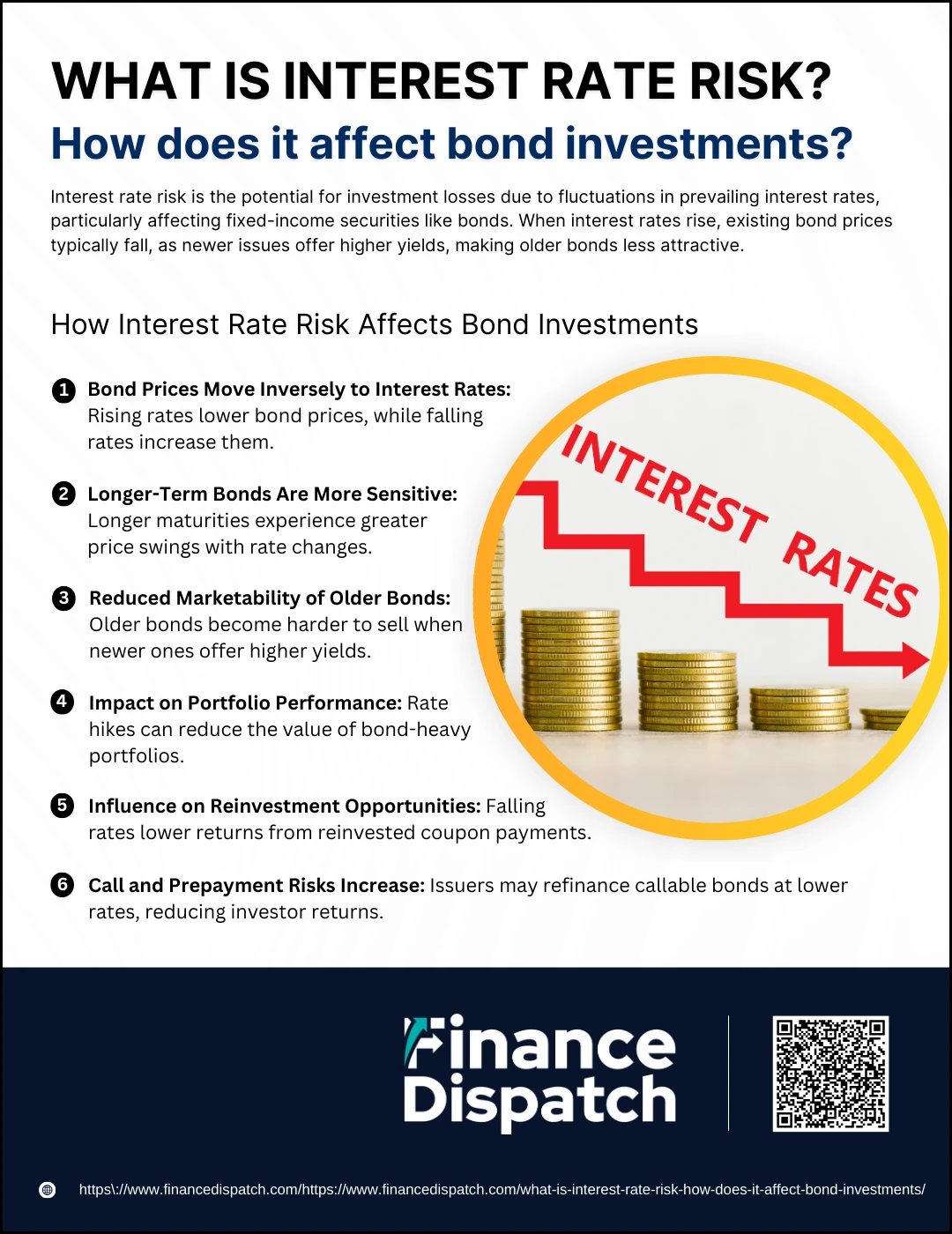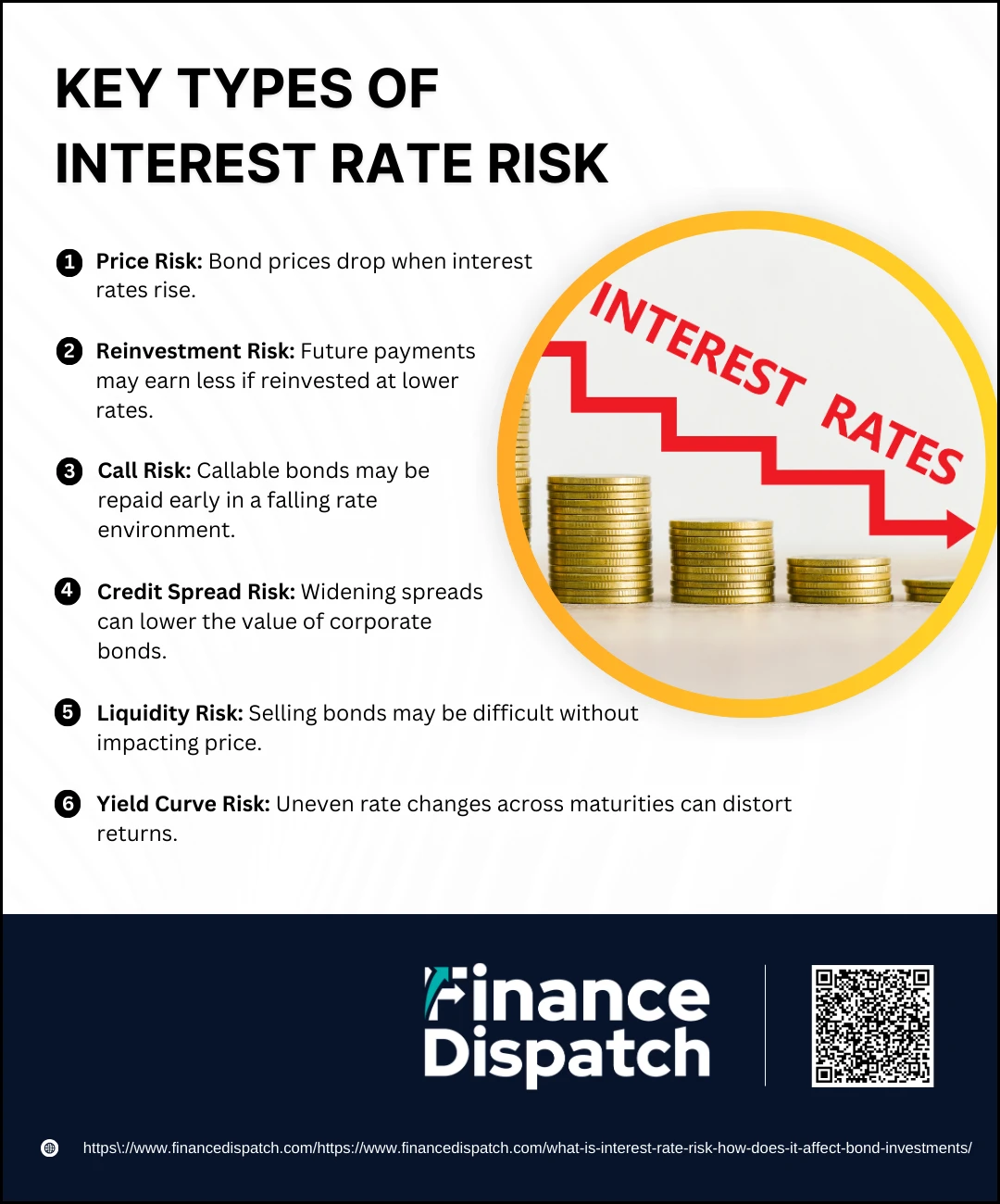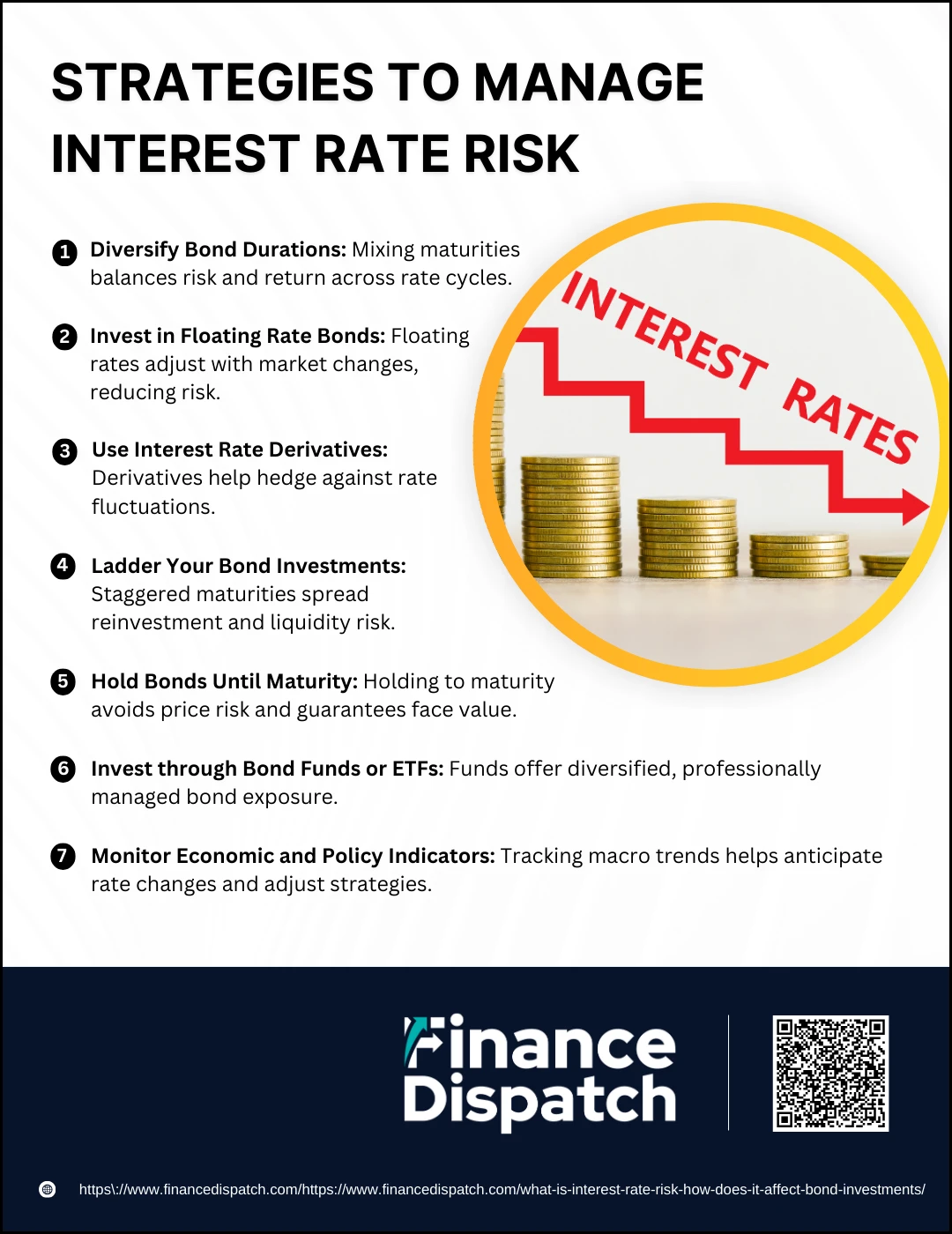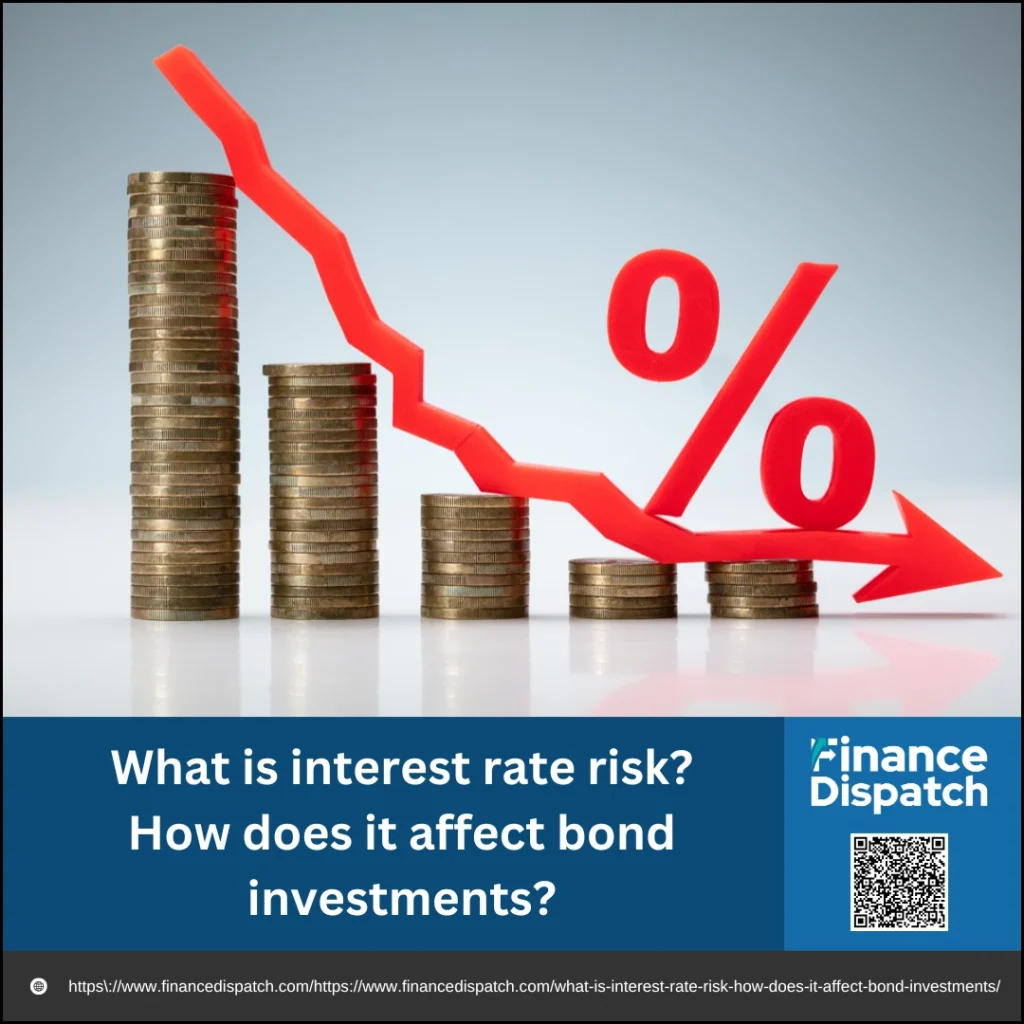Interest rate risk is one of the most important concepts for bond investors to understand. It refers to the potential for a bond’s value to fluctuate due to changes in market interest rates. While bonds are often seen as safer investments compared to stocks, their prices can decline significantly when interest rates rise. This inverse relationship between interest rates and bond prices makes it crucial for investors to grasp how interest rate risk works, how it affects bond performance, and what strategies can help manage it effectively.
What is Interest Rate Risk?
Interest rate risk is the potential for an investor to experience losses due to fluctuations in market interest rates, particularly affecting fixed-income securities like bonds. When interest rates rise, the prices of existing bonds typically fall because newer bonds offer more attractive yields, making older ones less desirable. Conversely, when interest rates drop, the value of existing bonds with higher fixed rates increases. This inverse relationship means that even though bonds provide steady income, their market value is not immune to changing economic conditions. Interest rate risk is most pronounced in longer-duration bonds, which are more sensitive to rate shifts.
 How Interest Rate Risk Affects Bond Investments
How Interest Rate Risk Affects Bond Investments
Interest rate risk is a fundamental factor that influences bond performance. When interest rates fluctuate, the market value of bonds responds—sometimes dramatically. This relationship is especially important for investors holding fixed-income securities because their value is directly tied to prevailing interest rates. Let’s explore the specific ways interest rate risk impacts bond investments:
1. Bond Prices Move Inversely to Interest Rates
The core principle of interest rate risk is the inverse relationship between interest rates and bond prices. When market interest rates rise, existing bonds with lower coupon rates become less attractive, causing their prices to drop. Conversely, when rates fall, those same bonds become more valuable because they offer a higher yield than newly issued ones.
2. Longer-Term Bonds Are More Sensitive
Bonds with longer maturities tend to be more volatile in response to interest rate changes. This is because investors are locked into a fixed rate for a longer period, increasing the impact of missed opportunities as market rates shift. A 10-year bond, for example, will typically lose more value than a 2-year bond if rates rise by the same amount.
3. Reduced Marketability of Older Bonds
When interest rates increase, new bonds offer better returns, making older, lower-yielding bonds harder to sell without offering a price discount. Investors seeking to exit their position before maturity may have to sell at a loss if market conditions are unfavorable.
4. Impact on Portfolio Performance
A bond-heavy portfolio is vulnerable to rate increases, especially if it includes many long-duration securities. Falling bond prices can lead to a decline in the portfolio’s market value, even if the investor doesn’t sell. This can be concerning for those needing liquidity or tracking short-term performance.
5. Influence on Reinvestment Opportunities
For investors who rely on periodic coupon payments, changes in interest rates also affect how they reinvest those payments. If rates fall, reinvested income will earn less, reducing the compound growth potential of the investment—this is known as reinvestment risk.
6. Call and Prepayment Risks Increase
When rates drop, issuers may take advantage by calling back their callable bonds and reissuing new ones at lower rates. This limits the investor’s potential to continue earning the original higher yield, and often forces them to reinvest at lower returns.
 Key Types of Interest Rate Risk
Key Types of Interest Rate Risk
Interest rate risk isn’t a single, uniform threat—it includes several specific types that impact bonds and fixed-income investments in different ways. Understanding these distinct categories can help investors recognize potential vulnerabilities in their portfolios and apply targeted risk management strategies.
Here are the key types of interest rate risk:
1. Price Risk
This is the risk that a bond’s market price will decline as interest rates rise. Since newer bonds offer higher yields in a rising rate environment, older bonds lose value to remain competitive.
2. Reinvestment Risk
This refers to the possibility that future coupon or principal payments will have to be reinvested at lower interest rates. It often occurs when interest rates fall, reducing the income potential from reinvested funds.
3. Call Risk
Some bonds are callable, meaning the issuer can repay the bond before maturity. In a declining interest rate environment, issuers may call bonds early and refinance at lower rates, forcing investors to reinvest proceeds at less favorable rates.
4. Credit Spread Risk
This is the risk that the difference in yields (spreads) between corporate bonds and government securities may widen, often due to market stress or deteriorating credit quality, which can reduce the market value of corporate bonds.
5. Liquidity Risk
Liquidity risk arises when an investor may be unable to sell a bond quickly without significantly affecting its price. This is especially relevant in volatile or thinly traded bond markets.
6. Yield Curve Risk
This occurs when changes in interest rates do not affect all maturities equally. If the yield curve shifts shape (e.g., flattens or steepens), it can impact bonds differently depending on their duration, potentially distorting expected returns.
Duration and Bond Sensitivity
Duration is a key measure used to assess how sensitive a bond’s price is to changes in interest rates. It helps investors understand the extent to which a bond’s value may rise or fall as rates shift. Generally, the longer the duration, the more the bond’s price will move in response to interest rate changes. This makes duration an essential tool for managing interest rate risk, especially when comparing bonds of different maturities.
Here’s a table illustrating how bond duration affects price sensitivity:
| Bond Maturity | Duration (Years) | Interest Rate Sensitivity | Impact of 1% Rate Increase |
| 1 year | 0.9 | Low | ~0.9% price decrease |
| 5 years | 4.5 | Moderate | ~4.5% price decrease |
| 10 years | 8.7 | High | ~8.7% price decrease |
| 30 years | 20.0 | Very High | ~20% price decrease |
Maturity Risk Premium
The maturity risk premium is the additional return that investors demand for holding longer-term bonds, which are more exposed to interest rate fluctuations over time. Since long-term bonds carry greater uncertainty due to the potential for significant rate changes, investors require higher yields to compensate for this added risk. This premium reflects the trade-off between locking in a fixed return for an extended period and the increased vulnerability to future rate shifts. As a result, longer-dated bonds typically offer higher yields than shorter-term ones, not necessarily because they are riskier in terms of default, but because they bear greater interest rate risk.
Real-World Examples: SVB Case Study
A notable example that highlights the impact of interest rate risk is the collapse of Silicon Valley Bank (SVB) in 2023. SVB invested heavily in long-term bonds when interest rates were low, aiming to secure stable returns. However, as the Federal Reserve raised interest rates sharply, the value of those bonds plummeted. This mismatch between assets and rising liabilities led to a liquidity crisis and ultimately, the bank’s failure. The SVB case demonstrates how mismanaging interest rate risk can have severe financial consequences—even for large institutions.
Key takeaways from the SVB case include:
1. Heavy Investment in Long-Term Bonds: SVB allocated a significant portion of its assets to long-duration bonds that were sensitive to rate increases.
2. Sharp Rise in Interest Rates: When the Fed raised rates, the market value of SVB’s bond holdings dropped dramatically.
4. Lack of Hedging Strategies: The bank did not adequately hedge its interest rate exposure, increasing its vulnerability.
5. Liquidity Crunch: As depositors began withdrawing funds, SVB was forced to sell devalued bonds at a loss to meet obligations.
6. Failure to Diversify Duration: The concentration in long-term bonds amplified losses as the interest rate environment changed rapidly.
 Strategies to Manage Interest Rate Risk
Strategies to Manage Interest Rate Risk
Interest rate fluctuations can significantly affect the value of fixed-income investments, especially bonds. While it’s impossible to eliminate interest rate risk entirely, investors can use a range of strategies to reduce its impact and better protect their portfolios. These strategies are particularly useful for maintaining income stability, managing capital preservation, and aligning bond investments with changing market conditions.
Here are key strategies to manage interest rate risk:
1. Diversify Bond Durations
Spreading investments across bonds with varying maturities—short, medium, and long-term—helps reduce overall portfolio sensitivity to interest rate changes. Shorter-term bonds are less affected by rate increases, while longer-term bonds may offer higher returns but carry more risk. A balanced mix can offer protection and opportunity in different rate environments.
2. Invest in Floating Rate Bonds
Floating rate bonds pay interest that resets periodically based on a benchmark rate, such as LIBOR or the Fed funds rate. These bonds are less vulnerable to rising interest rates because their payouts increase as rates rise, helping investors maintains competitive income levels even in volatile markets.
3. Use Interest Rate Derivatives
Derivative instruments like interest rate swaps, futures, and options allow investors to hedge against unfavorable interest rate movements. For example, an investor anticipating rising rates can enter into a swap agreement to receive a floating rate and pay a fixed rate, thereby offsetting potential bond losses.
4. Ladder Your Bond Investments
A bond ladder involves purchasing bonds that mature at staggered intervals (e.g., 1, 3, 5, 7, and 10 years). This structure spreads reinvestment risk and ensures that a portion of the portfolio becomes liquid at regular intervals, allowing reinvestment at potentially higher rates when older bonds mature.
5. Hold Bonds Until Maturity
If an investor holds a bond to maturity, its market price fluctuations become irrelevant—as the investor will receive the full face value along with the promised interest payments. This strategy eliminates price risk, making it a good option for conservative investors who prioritize income and capital preservation over trading gains.
6. Invest through Bond Funds or ETFs
Bond mutual funds and exchange-traded funds (ETFs) provide diversified exposure to multiple bonds and are often managed by professionals who actively respond to interest rate trends. Some funds are even structured with specific duration targets, enabling investors to select options based on their risk preferences and rate outlook.
7. Monitor Economic and Policy Indicators
Keeping an eye on economic data such as inflation, employment, GDP growth, and central bank policies (like Federal Reserve rate decisions) can help investors anticipate future interest rate movements. Being proactive with this information enables timely portfolio adjustments to minimize risk and maximize returns.
Interest Rate Risk vs. Credit Risk
When investing in bonds, it’s important to distinguish between two major types of risk: interest rate risk and credit risk. While both can affect the value of a bond, they stem from different sources. Interest rate risk arises from changes in market interest rates, impacting bond prices inversely. Credit risk, on the other hand, refers to the possibility that a bond issuer may fail to make timely interest payments or repay the principal. Understanding the difference between these risks is essential for building a well-balanced bond portfolio.
Here’s a comparison of interest rate risk and credit risk:
| Aspect | Interest Rate Risk | Credit Risk |
| Definition | Risk of bond value changing due to interest rate fluctuations | Risk of issuer defaulting on interest or principal payments |
| Source of Risk | Market-driven interest rate changes | Financial health and creditworthiness of the bond issuer |
| Impact on Bond Price | Causes price to fall when rates rise and rise when rates fall | Causes price to drop if issuer’s credit rating declines |
| Affected Bonds | All bonds, especially long-term and fixed-rate bonds | Mainly corporate bonds, municipal bonds, and low-rated issues |
| Measurement Tool | Duration, yield curve analysis | Credit ratings (Moody’s, S&P, Fitch), credit spreads |
| Management Strategy | Adjust bond durations, hedge with derivatives, laddering | Choose high-quality issuers, diversify, monitor credit ratings |
Conclusion
Interest rate risk is an essential factor every bond investor must understand. It affects the market value of fixed-income securities and can lead to significant gains or losses depending on the direction of interest rate movements. While bonds are often seen as stable investments, they are not immune to the effects of rising or falling rates. By recognizing how interest rate risk works, identifying its various forms, and implementing effective strategies—such as diversification, duration management, and the use of hedging tools—investors can better protect their portfolios. Being aware of the difference between interest rate risk and credit risk also enables more informed investment decisions. Ultimately, managing interest rate risk is key to preserving capital and achieving consistent returns in a changing financial environment.



